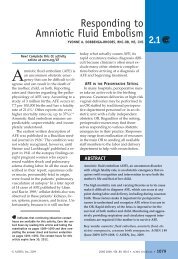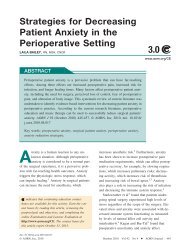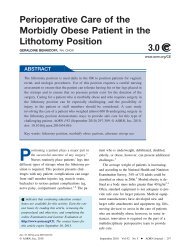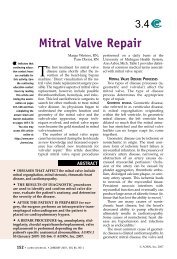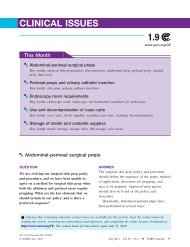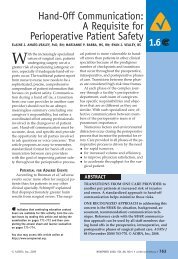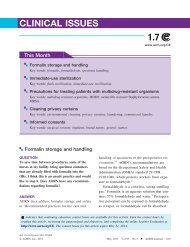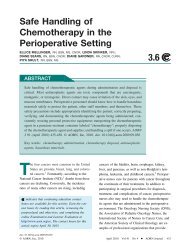Perioperative Care of the Patient with Bipolar Disorder ... - AORN
Perioperative Care of the Patient with Bipolar Disorder ... - AORN
Perioperative Care of the Patient with Bipolar Disorder ... - AORN
You also want an ePaper? Increase the reach of your titles
YUMPU automatically turns print PDFs into web optimized ePapers that Google loves.
August 2010 Vol 92 No 2 SAUNDERS<br />
disorder lead healthy and productive lives, and, in<br />
most cases, treatment can help reduce <strong>the</strong> frequency<br />
and severity <strong>of</strong> episodes.<br />
NURSING IMPLICATIONS<br />
Individuals <strong>with</strong> bipolar disorder may have frequent<br />
crises in <strong>the</strong>ir lives as a result <strong>of</strong> <strong>the</strong>ir problems<br />
<strong>with</strong> interpersonal relationships, stress, ineffective<br />
coping and problem-solving skills,<br />
fluctuating employment status and social support<br />
systems, substance-related problems, and possible<br />
legal problems. 3 What may seem like a small<br />
stressor to <strong>the</strong> nurse (eg, a minor surgical procedure)<br />
may be interpreted as a major stressor by<br />
<strong>the</strong> patient. <strong>Perioperative</strong> nursing implications for<br />
nurses who care for patients <strong>with</strong> bipolar disorder<br />
are provided in Table 1. The nurse should perform<br />
an accurate and early mood assessment because<br />
a prevailing mood <strong>of</strong> increased anxiety or<br />
quick shifts <strong>of</strong> mood must be identified before <strong>the</strong><br />
mood escalates to excessive overactivity, impulsivity,<br />
distractibility, inability to control behavior,<br />
anger, and/or aggression. A family member may<br />
be able to provide insight into <strong>the</strong> patient’s psychiatric<br />
history.<br />
To decrease <strong>the</strong> patient’s anxiety and possible<br />
paranoia, <strong>the</strong> nurse should not wear a surgical hat<br />
and mask when first meeting <strong>the</strong> patient. To make<br />
<strong>the</strong> patient feel safe, <strong>the</strong> nurse should provide<br />
structure and control by<br />
� using a firm and calm approach;<br />
� giving short and concise explanations;<br />
� remaining neutral and avoiding power<br />
struggles;<br />
� staying consistent in approach and<br />
expectations;<br />
� setting limits in a firm, nonthreatening and<br />
neutral manner; and<br />
� redirecting <strong>the</strong> patient’s energy into more appropriate<br />
and constructive avenues.<br />
If <strong>the</strong> patient becomes overwhelmed <strong>with</strong> feelings<br />
<strong>of</strong> insecurity and anxiety, he or she may be<br />
214 <strong>AORN</strong> Journal<br />
prone to self-harm or violence toward o<strong>the</strong>rs.<br />
Therefore, crisis intervention by <strong>the</strong> nurse has two<br />
basic initial goals: ensuring <strong>the</strong> patient’s safety<br />
and reducing <strong>the</strong> patient’s anxiety to prevent<br />
fur<strong>the</strong>r escalation <strong>of</strong> mania to help provide safe<br />
boundaries for <strong>the</strong> patient and o<strong>the</strong>rs.<br />
If <strong>the</strong> patient is becoming increasingly manic<br />
(eg, anxious, agitated, distractible, excitable), <strong>the</strong>n<br />
<strong>the</strong> nurse should move <strong>the</strong> patient to a quiet place<br />
to maintain a low level <strong>of</strong> stimuli away from<br />
bright lights, loud noises, and people. The patient<br />
should be <strong>with</strong>in view <strong>of</strong> staff members or, if <strong>the</strong><br />
patient is not visible to staff members, <strong>the</strong>n it is<br />
important that someone stay <strong>with</strong> him or her. This<br />
could be a staff member or a family member or<br />
friend, because family members and friends have<br />
been identified as major support systems for individuals<br />
<strong>with</strong> severe mental illness. 9 Frequent observation<br />
by <strong>the</strong> nurse, however, is still needed.<br />
The nurse’s presence provides support, and, if<br />
needed, <strong>the</strong> nurse can direct <strong>the</strong> patient’s energy<br />
into nonstimulating and calming solitary activities<br />
(eg, listening to s<strong>of</strong>t music, drawing or writing,<br />
walking slowly in <strong>the</strong> room) to help minimize<br />
excitability. The structure that <strong>the</strong> nurse creates<br />
provides <strong>the</strong> patient <strong>with</strong> security and focus. The<br />
nurse can demonstrate respect for <strong>the</strong> patient’s<br />
personal space by keeping at least 1.5 feet to 3<br />
feet between himself or herself and <strong>the</strong> patient, so<br />
that <strong>the</strong> patient does not perceive <strong>the</strong> nurse as<br />
being intrusive. To maintain reduced environmental<br />
stimuli, it is ideal to have only one nurse interacting<br />
<strong>with</strong> <strong>the</strong> patient, but o<strong>the</strong>r staff members<br />
need to maintain an unobtrusive presence in case<br />
<strong>the</strong> patient’s mood and/or behavior escalates.<br />
To help calm a patient who becomes overexcited<br />
or angry, <strong>the</strong> nurse can use de-escalation<br />
techniques to help diffuse <strong>the</strong> situation. For example,<br />
speaking in a calm, nonthreatening, and caring<br />
manner can help <strong>the</strong> patient feel less anxious.<br />
Although it may be difficult for <strong>the</strong> nurse to remain<br />
calm when faced <strong>with</strong> an angry patient, it is<br />
important to maintain a calm demeanor because



